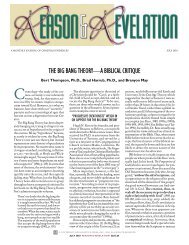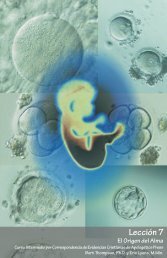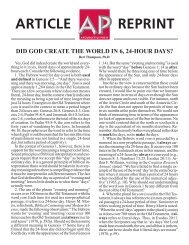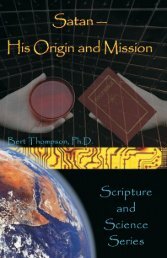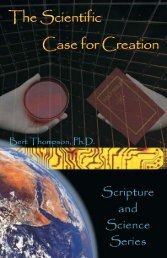Origins: Random Chance or Intelligent Design? - Apologetics Press
Origins: Random Chance or Intelligent Design? - Apologetics Press
Origins: Random Chance or Intelligent Design? - Apologetics Press
- No tags were found...
Create successful ePaper yourself
Turn your PDF publications into a flip-book with our unique Google optimized e-Paper software.
—BT/BH]...demonstrate some surprisingly modern engineering ideas” (1974,p. 43). Who initiated these “engineering ideas”? The answer, of course, isthe Great Engineer, God.The SkinThe skin is the largest single <strong>or</strong>gan of the human body. It consists of threeareas: (a) the skin layers; (b) the glands; and (c) the nails. If the skin of a 150-pound man were spread out, it would cover 20 square feet of space and weighabout 9 pounds. The skin is also a very busy area. “A piece of skin the size ofa quarter contains 1 yard of blood vessels, 4 yards of nerves, 25 nerve ends,100 sweat glands, and m<strong>or</strong>e than 3 million cells” (Youmans, 1979, 17:404d).The skin abs<strong>or</strong>bs ultraviolet rays from the Sun, and uses them to convert chemicalsinto vitamin D, which the body needs f<strong>or</strong> the utilization of calcium. It retainsthe fluids in the body, and yet still is permeable enough f<strong>or</strong> perspirationto penetrate in <strong>or</strong>der to cool the body. And, the skin is the primary means ofdefense against bacteria and other harmful <strong>or</strong>ganisms. Man has yet to developa durable material that can perf<strong>or</strong>m the many functions that the skincarries out on a daily basis.The EyeOne of the most f<strong>or</strong>ceful evidences of design within the human body isthe eye. Even Charles Darwin struggled with the problem of an <strong>or</strong>gan so complexas the eye evolving via naturalistic processes. In The Origin of Specieshe wrote:To suppose that the eye with all its inimitable contrivances f<strong>or</strong> adjustingthe focus to different distances, f<strong>or</strong> admitting different amountsof light, and f<strong>or</strong> the c<strong>or</strong>rection of spherical and chromatic aberration,could have been f<strong>or</strong>med by natural selection, seems, I freely confess,absurd in the highest sense(1859,p.170,emp.added).However, in spite of his misgivings, Darwin went on to argue that the eye had,in fact, been produced by natural selection through an evolutionary process.Darwin, of course, is not the only one to be troubled by what appears to beobvious evidence of design in the eye. Evolutionist Robert Jastrow lamented:The eye is a marvelous instrument, resembling a telescope of the highestquality,with a lens, an adjustable focus, a variable diaphragm f<strong>or</strong>controlling the amount of light, and optical c<strong>or</strong>rections f<strong>or</strong> sphericaland chromatic aberration. The eye appears to have been designed;no designer of telescopes could have done better. Howcould this marvelous instrument have evolved by chance, througha succession of random events? (1981, pp. 96-97, emp. added).Considering how extremely complex the mechanism of the eye is knownto be, it is easy to understand why Dr. Jastrow would make such a comment.Light images from the environment enter the eye (at approximately 186,000miles per second) through the iris, which opens and shuts like the diaphragmof a camera to let in just the right amount of light. The images move through4




